The problem is that we are exploring environments based upon irrational numbers through computer machinery which works with finite rationals ! ( Alessandro Rosa )
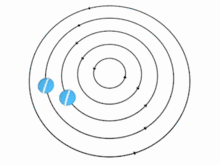
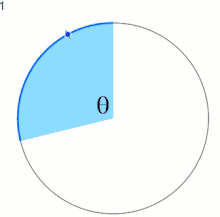
For Siegel disc [1][2] parameter c :
- should be on boundary of hyperbolic component of Mandelbrot set ( internal radius = 1)
- internal angle should be irrational number between 0 and 1 .[3]
Because set of irrationals is uncountable[4] so the number of Julia sets with Siegel disc is infinite.
Definitions
 Critical orbit tending to weakly attracting fixed point.When point c goes from center to boundary along internal ray for irrational internal angle then critical orbit changes from one point thru spiral to circle surranding fixed point alpha.
Critical orbit tending to weakly attracting fixed point.When point c goes from center to boundary along internal ray for irrational internal angle then critical orbit changes from one point thru spiral to circle surranding fixed point alpha.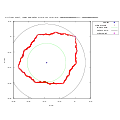 Critical Orbit, Inner and outer circle for Golden Mean Quadratic Julia set
Critical Orbit, Inner and outer circle for Golden Mean Quadratic Julia set
Center
Center of Siegel disc is a irrationally indifferent periodic point.
Mane's theorem :
"... appart from its center, a Siegel disk cannot contain any periodic point, critical point, nor any iterated preimage of a critical or periodic point. On the other hand it can contain an iterated image of a critical point." [5]
Center component of Julia set
In case of c on boundary of main cardioid center component of Julia set is a component containing Siegel disc ( and its center). Critical orbit is a boundary of Siegel disc and center component. All other components are preimages of this component ( see animated image using inverse iterations ).
Radius
Conformal radius
Inner radius
Inner radius of Siegel Disc =
- radius of inner circle, where inner circle with center at fixed point is the biggest circle inside Siegel Disc.[8]
- minimal distance between center of Siel Disc and critical orbit
Code for computing internal radius :
Maxima CAS code
Here orbit is a list of complex points z.
f(z,c):=z*z+c $ GiveCriticalOrbit(c,iMax):= block( ER:2.0, /* Escape Radius */ z:0+0*%i, /* first point = critical point */ orbit:[z], if (abs(z)>ER) then return(orbit), i:0, loop, /* compute forward orbit */ z:rectform(f(z,c)), orbit:endcons(z,orbit), i:i+1, if ((abs(z)<ER) and (i<iMax)) then go(loop), return(orbit) )$ /* find fixed point alfa */ GiveFixed(c):= float(rectform((1-sqrt(1-4*c))/2))$ /* distance between point z and fixed point zf */ GiveDistanceFromCenterTo(z):= abs(z-zf)$ /* inner radius of Siegel Disc ; criticla orbit is a boundary of SD */ GiveInnerRadiusOf(orbit):=lmin(map(GiveDistanceFromCenterTo,orbit))$ /* outer radius of Siegel Disc ; criticla orbit is a boundary of SD */ GiveOuterRadiusOf(orbit):=lmax(map(GiveDistanceFromCenterTo,orbit))$ /*------------ const ---------------------------------*/ c:0.113891513213121 +0.595978335936124*%i; /* fc(z) = z*z + c */ NrPoints:400000; /* ----------- main ---------------------------------------------------*/ zf:GiveFixed(c); /* fixed point = center of Siegel disc */ orbit:GiveCriticalOrbit(c,NrPoints)$ innerRadius: GiveInnerRadiusOf(orbit) ; outerRadius: GiveOuterRadiusOf(orbit) ;
C code
double GiveInternalSiegelDiscRadius(complex double c, complex double a)
{ /* compute critical orbit and finds smallest distance from fixed point */
int i; /* iteration */
double complex z =0.0; /* critical point */
/* center of Siegel disc = a */
double d; // distance
double dMin = 2.0;
for (i=0;i<=40000 ;i++) /* to small number of iMax gives bad result */
{
z = z*z + c;
/* */
d = cabs(z - a);
if (d < dMin) dMin = d; /* smallest distance */
}
return dMin;
}
Outer radius
Outer radius of Siegel Disc = radius of outer circle.
Outer circle with center at fixed point is minimal circle containing Siegel disc.
C code :
double GiveExternalSiegelDiscRadius(complex double c, complex double a)
{ /* compute critical orbit and finds smallest distance from fixed point */
int i; /* iteration */
double complex z =0.0; /* critical point */
/* center of Siegel disc = a */
double d; // distance
double dMax = 0.0;
for (i=0;i<=40000 ;i++) /* to small number of iMax gives bad result */
{
z = z*z + c;
/* */
d = cabs(z - a);
if (d > dMax) dMax = d; /* biggest distance */
}
return dMax;
}
Folding
Folding in scholaredia[9]
Siegel disk implosion
" ... an arbitrary small change of the multiplier of the Siegel point may lead to an implosion of the Siegel disk - its inner radius collapses to zero " [10]
Examples :
- from Golden Mean Siegel Disc with rotation number = [0;1,1,1,1,1, ...]= 0.618033988957902 to parabolic Julia set with rotation number (internal angle) = 5/8 = [0;1,1,1,1,1]
- SEMI-CONTINUITY OF SIEGEL DISKS UNDER PARABOLIC IMPLOSION : P(n) = [0, 2, 2, n + r] with r = (√5−1)/ 2 , the first three images show the Siegel disk of P(n) for n = 10, 500, 10000, and the last is the virtual Siegel disk of p/q = 2/5 they tend to. Here P(n) > p/q.[11]
Types
for c :
- on boundary of main cardioid are siegel discs around fixed point alfa
- on boundary of period n component are periodic Siegel discs around n-periodic points
These Siegel Discs are :
- bounded (because the Julia set is bounded)
- not smooth (differentiable) in general
Around fixed point
- Julia set consist of infinitely many curves bounding open regions
- maps each region into "larger" one, until the region containing the fixed point is reached
- inside component containing Siegel disc rotates points on invariant loops around the fixed point[12]
so in other words :
" has infinitely many components. One of these contains the alpha fixed point. It is mapped to itself by . This is the Siegel disk."
"The Siegel disk is one component and it has infinitely many preimages. If you zoom in to z = 0 with large nmax, you shall see that there are two components touching at z=0". ( Wolf Jung )
Visualisation
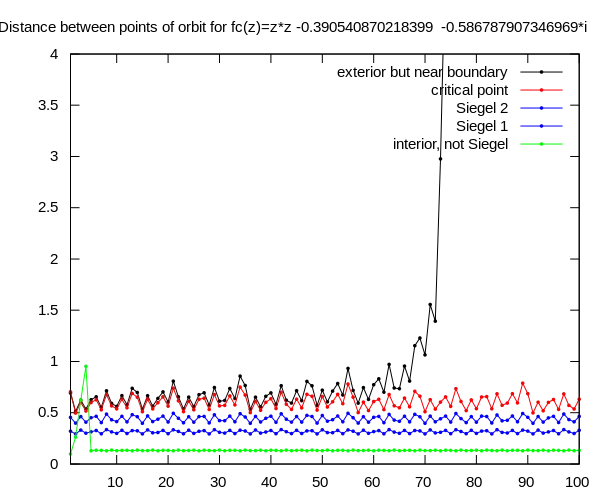
Visualisation of dynamical plane :
- critical orbit by forward iteration of critical point
- Julia set by
- boundary of center component by drawing of critical orbit
- whole Julia set by inverse iteration of critical orbit
- interior
- whole interior by average velocity by Chris King
- Siegel disc orbits by forward iteration of point inside or on boundary of Siegel Disc[13]
Average velocity by Chris King
Discrete Velocity of non-attracting Basins and Petals: Compute, for the points that don't escape, the average discrete velocity on the orbit[14]
 in c
in c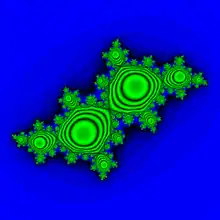 in octave
in octave
Optimisation
See also general methods
Trick 1
If point ( z0 or its forward image zn) is inside inner circle then it is interior point.
Examples
Methods
- Continued fractions
- t = [3,2,1000,1,.] = 0.28573467254058817026888613062003 . It gives c = -0.096294753554390530825955047963 + 0.648802699422348309293468536773i[15]
- known aproximations of irrational numbers
- 1/pi
- eulers number
- golden ratio
- roots of numbers, like
- squarre roots: sqrt(2), sqrt(3), sqrt(5), sqrt(7), sqrt(8), sqrt(15), sqrt(21), sqrt(35), sqrt(49), SQRT(65), sqrt(99), SQRT(100), SQRT(101), SQRT(121), sqrt(200), sqrt(278),
- cubic roots, cbrt(3),
- logarithms, like
- descendants of above numbers:
- like 1/pi
- sum of irrational and rational number : if t is an irrational number and r is a rational the t+r is irrational
- fast converging series [16]
Sequences
Sequence of Continued fraction:[17]
- [1, 1, 1, . . .]
- [1, 1, 1, 20, 1, . . .]
- [1, 1, 1, 20, 1, 1, 1, 30, 1, . . .]
sequence from Siegel disk to Lea-Fatou flower:
- plain
- digitated
- virtual
- Leau-Fatou flower
| cf(t) | t | c(t) | internal adress | center z | period | inner R | outer R |
|---|---|---|---|---|---|---|---|
| [0; 1, 1, 1,...] | 0.618033988957902 | -0.390540870218399-0.586787907346969i | -0.368684439039160-0.337745147130762i | 1 | 0.25 | 0.4999 | |
| [0;3,2,1000,1...] | .2857346725405882 | 0.113891513213121+0.595978335936124i | -0.111322907374331+0.487449700270424i | 1 | .1414016645283217 | .5285729063154562 | |
values
- t = 0.3119660900888915 = [0, 3, 4, 1, 6, 1, 1, 65, 7, 1, 2, 63] ; c = -0.01183223669 + 0.63816572702*%i [18]
- t = 0.3572354109849235 = [0, 2, 1, 3, 1, 54, 2, 1, 17, 1, 1, 1, 12, 1, 1, 1, 2, 2] ; c = -0.256625459 + 0.6345309*%i
- t = 0.3573615246360573 = [0, 2, 1, 3, 1, 22, 1, 1, 4, 1, 5, 1, 4, 3, 2, 21] ; c = -0.257341 + 0.634456*%i
Boundary of main cardioid
- examples by Jay Hill[19]
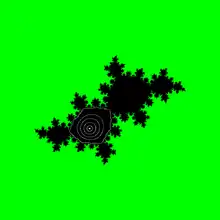 Dynamical plane for Golden Mean with Critical orbit and some orbits inside Siegel Disc
Dynamical plane for Golden Mean with Critical orbit and some orbits inside Siegel Disc Golden Mean Quadratic Siegel Disc with interior coloured by average discrete velocity on the orbit
Golden Mean Quadratic Siegel Disc with interior coloured by average discrete velocity on the orbit high resolution gray version
high resolution gray version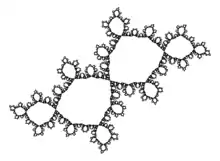 Julia set for Golden Mean made with IIM/J
Julia set for Golden Mean made with IIM/J animated version - up to level 100
animated version - up to level 100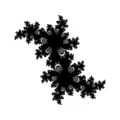 Julia set of quadratic polynomial with Siegel disk for rotation number [3,2,1000,1...]
Julia set of quadratic polynomial with Siegel disk for rotation number [3,2,1000,1...]_%253D_z*z%252Bc_where_c_%253D_-0.749998153581339_%252B0.001569040474910*I%253B_t_%253D_0.49975027919634618290.png.webp)
Parametrization
The boundary of main cardioid is described by 2 simultaneous equations :
- describing fixed point ( period 1 ) under f
- describing multiplier[20] ( stability ) of fixed point ( it should be indifferent)
where :
First equation :
Second equation :
As a result one gets function describing relation between parameter c and internal angle t :
It is used for computing :
- c point of boundary of main cardioid
- when t is irrational number then filled Julia set has Siegel disc
One can compute boundary point c
of period 1 hyperbolic component ( main cardioid) for given t using
t = atan2(); // is the argument in radians.
cx = 0.5*cos(t) - 0.25*cos(2*t);
cy = 0.5*sin(t) - 0.25*sin(2*t);
New parameter can be computed after increasing t using arbitrary step:
t += 0.01; // It is increased by 0.01 so 1/628 turns. // From the new t the new parameter c is computed ..
near Liouville numbers
t = 0.7656250596046448 gives :
- c = 0.294205040086005 -0.448819580822501*i on the main cardioid
- c = -0.975495621741693 -0.248796172491005*i on the period 2 component
- c = -0.219419079596579 +0.741123657495634*i on the period 3 component aalong internal ray 1/3
- c = -1.749557112879525 -0.008859942836393*i on the small period 3 cardioid on the main antenna
where ! denotes factorial.
Image :
Maxima cas code:
f(n) := n^-1 + n^-2 +n^-6 +n^-24;
%i2) f(2);
12845057
(%o2) --------
16777216
(%i3) float(f(2));
(%o3) 0.7656250596046448
(%i4) float(f(3));
(%o4) 0.445816186560468
(%i5) f(3);
125911658926
(%o5) ------------
282429536481
(%i6) f(5);
14308929443359376
(%o6) -----------------
59604644775390625
(%i7) f(6);
921453486852538369
(%o7) -------------------
4738381338321616896
(%i8) f(7);
31280196802261814842
(%o8) ---------------------
191581231380566414401
(%i9) f(8);
664100801052053340161
(%o9) ----------------------
4722366482869645213696
(%i10) 8^24;
(%o10) 4722366482869645213696
radians
- 1/(2*pi) = 0.1591549430918953
- 2/(2*pi) = 0.3183098861837907
- 3/(2*pi) = 0.477464829275686
- 4/(2*pi) = 0.6366197723675814
- 5/(2*pi) = 0.7957747154594768
- 6/(2*pi) = 0.954929658551372
Images:
- examples by Kerry Mitchell examples by Kerry Mitchell
the Golden Mean
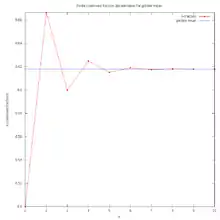
rotation number t is the Golden Mean ( exactly Golden ratio conjugate,[21] compare Julia set for Golden Mean which is disconnected Julia set [22]
Continued_fraction expansion :[23]
In Maxima CAS :
(%i2) a:[0,1,1,1,1,1,1,1,1,1,1,1,1,1,1,1,1,1,1,1,1,1,1,1] (%o2) [0,1,1,1,1,1,1,1,1,1,1,1,1,1,1,1,1,1,1,1,1,1,1,1] (%i3) t:cfdisrep(a) (%o3) 1/(1+1/(1+1/(1+1/(1+1/(1+1/(1+1/(1+1/(1+1/(1+1/(1+1/(1+1/(1+1/(1+1/(1+1/(1+1/(1+1/(1+1/(1+1/(1+1/(1+1/(1+1/(1+1/1)))))))))))))))))))))) (%i4) float(t) (%o4) 0.618033988957902 (%i5) l:%e^(2*%pi*%i*t) (%o5) %e^(-(17711*%i*%pi)/23184) (%i6) c:(l*(1-l/2))/2 (%o6) ((1-%e^(-(17711*%i*%pi)/23184)/2)*%e^(-(17711*%i*%pi)/23184))/2 (%i7) float(rectform(c)) (%o7) -.5867879078859505*%i-.3905408691260131
so
Compare with :
- Quadratic Julia sets depicted by combined methods[24]
- Golden mean Siegel disk by Curtis T McMullen [25]
- Siegel Disk Fractal by Jim Muth [26]
- Siegel disk by Davoud Cheraghi[27]
- a bettter Siegel disk program in Mathematica From Roger Bagula[28]
- Xander's image [29]
- Images by Arnaud Chéritat[30]
- irrational by Faber
Rays landing on the critical point
There are 2 rays landing on the critical point z=0 with angles:[31]
Here[32]
where the powers of 2 form the Fibonacci sequence :[33]
These rays are preimages of ray which land on the critical value.
digitated
algorithm goes like this :
- start with rational number p/q ( q is a number of digits
- find continous fraction of p/q using for example : wolfram alpha
- lets choose 2/7 = [0; 3, 2]
- for n from 0 to 10 compute rotation number = t(n) = [0;3, 2 , 10^n, golden_ratio]
- for each t compute multiplier m = e^(2*pi*i*t) and c = (m*(1-m/2))/2,
- for each c draw critical orbit
1/2
 Siegel disk for c = -0.749998153581339 +0.001569040474910 i
Siegel disk for c = -0.749998153581339 +0.001569040474910 i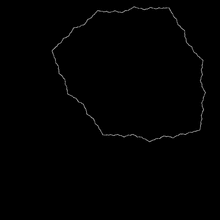 Infolding Siegel disk
Infolding Siegel disk Animation with external rays. Last frame show parabolic Julia set
Animation with external rays. Last frame show parabolic Julia set_%253D_z*z%252Bc_where_c_%253D_-0.749998153581339_%252B0.001569040474910*I%253B_t_%253D_0.49975027919634618290.png.webp)
[0;2,10^0, GoldenRatio] = 0.3819660112501051517954131656343618822796908201942371378645513772947395371810975502927927958106088625[34] [0;2,10^1, GoldenRatio] = 0.4775140100981009996157078147705459192853678713412804123092036673992538239565035505055878663397199776 [0;2,10^2, GoldenRatio] = 0.4975276418049443654168822249489777631733396751888937557910272646236455872099717190261209452982670182 [0;2,10^3, GoldenRatio] = 0.4997502791963461829064406841975638383643273854865268095992275328965717970298619920531024931799175222 [0;2,10^4, GoldenRatio] = 0.4999750027947725068093934556288852812751613102402893275180237493139184231871314468863992103480081398 [0;2,10^5, GoldenRatio] = 0.4999975000279505372222411883578948194038778053684924551662056284491619191237767514609446551752982620 [0;2,10^6, GoldenRatio] ≈ 0.4999997500002795081846878230972820064874630120375394060599983649731088601118927011908445914889153575 [0;2,10^7, GoldenRatio] ≈ 0.4999999750000027950846593747720590697092705648336656666550099352279885262457471130077351190950368647 [0;2,10^8, GoldenRatio] ≈ 0.4999999975000000279508494062473746989708466400627903143635595029928608488311534417391176743667414601 [0;2,10^9, GoldenRatio] = 0.4999999997500000002795084968749737124005323296851266699307427070578490529472905394986264318888387868 [0;2,10^10, GoldenRatio] ≈ 0.4999999999750000000027950849715622371205464056480586232583076030201151399460674665945145904063730995 [0;2,10^11, GoldenRatio] ≈ 0.4999999999975000000000279508497184348712051181647153557573019083692657334910230489541137897282568504 [0;2,10^12, GoldenRatio] ≈ 0.4999999999997500000000002795084971871612120511470579770310133815923588852631868226288826667637222837 [0;2,10^13, GoldenRatio] ≈ 0.4999999999999750000000000027950849718744246205114671208526574427310807059077461659968395909016599809 [0;2,10^14, GoldenRatio] ≈ 0.4999999999999975000000000000279508497187470587051146708626348091578511118332834054112155667123629005 [0;2,10^15, GoldenRatio] ≈ 0.4999999999999997500000000000002795084971874733995511467085917589150515616367008796489196018543201296 [0;2,10^16, GoldenRatio] ≈ 0.4999999999999999750000000000000027950849718747368080114670859141302328629213837245072986771954833911 [0;2,10^17, GoldenRatio] ≈ 0.4999999999999999975000000000000000279508497187473708926146708591409564368639443385654331302200729603 [0;2,10^18, GoldenRatio] ≈ 0.4999999999999999997500000000000000002795084971874737117386467085914095297794629164357828552071705414 [0;2,10^19, GoldenRatio] ≈ 0.4999999999999999999750000000000000000027950849718747371201989670859140952943357115116628413693411086 [0;2,10^20, GoldenRatio] ≈ 0.4999999999999999999975000000000000000000279508497187473712048021708591409529430112233513589149747868 ... [0;2] = 1/2 = 0.5
using quad double precision :
t(0) = 3.81966011250105151795413165634361882279690820194237137864551377e-01 ; c = -3.90540870218400050669762600713798485817583715938583500790716491e-01 ; 5.86787907346968751196714643055715840096745752123320842032245424e-01 t(1) = 4.77514010098100999615707814770545919285367871341280412309203667e-01 ; c = -7.35103725789203166246364354183070697092321099215970115885457098e-01 ; 1.40112549815936743590686010452273467218741353649054870130630558e-01 t(2) = 4.97527641804944365416882224948977763173339675188893755791027265e-01 ; c = -7.49819025417749776930986763368388660297294249313031793877713589e-01 ; 1.55327228158391795314525351457527867568101147692293037994954915e-02 t(3) = 4.99750279196346182906440684197563838364327385486526809599227533e-01 ; c = -7.49998153581339423261635407668242134664913541791449158951684018e-01 ; 1.56904047490965613194389295941701415441031256575211288282884094e-03 t(4) = 4.99975002794772506809393455628885281275161310240289327518023749e-01 ; c = -7.49999981498629125645545136832080395069079925634197165921129604e-01 ; 1.57062070991569266952536106210409130728490029437750411952649155e-04 t(5) = 4.99997500027950537222241188357894819403877805368492455166205628e-01 ; c = -7.49999999814949055379035496840776829777984829652802229165703441e-01 ; 1.57077876479293075511736069683515881947782844720535147967721515e-05 t(6) = 4.99999750000279508184687823097282006487463012037539406059998365e-01 ; c = -7.49999999998149453312747388186444210086067957518121660969151546e-01 ; 1.57079457059156244743576144811256589754652192800174232944684020e-06 t(7) = 4.99999975000002795084659374772059069709270564833665666655009935e-01 ; c = -7.49999999999981494495885914313759501577872560098720076587742563e-01 ; 1.57079615117453182906803046090425827728536858759594155863970088e-07 t(8) = 4.99999997500000027950849406247374698970846640062790314363559503e-01 ; c = -7.49999999999999814944921617531908891370473818724298060108792696e-01 ; 1.57079630923285982648802540286825950414334929521039394902627564e-08 t(9) = 4.99999999750000000279508496874973712400532329685126669930742707e-01 ; c = -7.49999999999999998149449178933702694145524879491347408142864355e-01 ; 1.57079632503869293681972526129998193269783324874397448954896142e-09 t(10) = 4.99999999975000000002795084971562237120546405648058623258307603e-01 ; c = -7.49999999999999999981494491752095410030080568840077963364830374e-01 ; 1.57079632661927625095878938346134344643704271149725816320948648e-10 t(11) = 4.99999999997500000000027950849718434871205118164715355757301908e-01 ; c = -7.49999999999999999999814944917483712483337770357969922549543000e-01 ; 1.57079632677733458240375473417333652732358282974043728923647563e-11 t(12) = 4.99999999999750000000000279508497187161212051147057977031013382e-01 ; c = -7.49999999999999999999998149449174799883216409502184216102177862e-01 ; 1.57079632679314041554856185862662707966424239622019267641300599e-12 t(13) = 4.99999999999975000000000002795084971874424620511467120852657443e-01 ; c = -7.49999999999999999999999981494491747961590547126303840172625197e-01 ; 1.57079632679472099886304567696577418001577729533565273081497266e-13 t(14) = 4.99999999999997500000000000027950849718747058705114670862634809e-01 ; c = -7.49999999999999999999999999814944917479578663854294268739087328e-01 ; 1.57079632679487905719449408985862706763478042275954257084690447e-14 t(15) = 4.99999999999999750000000000000279508497187473399551146708591759e-01 ; c = -7.49999999999999999999999999998149449174795749396925973912562169e-01 ; 1.57079632679489486302763893145850173816965190682509858763917154e-15 t(16) = 4.99999999999999975000000000000002795084971874736808011467085914e-01 ; c = -7.49999999999999999999999999999981494491747957456727642770350276e-01 ; 1.57079632679489644361095341562159509904086589961983101670245908e-16 t(17) = 4.99999999999999997500000000000000027950849718747370892614670859e-01 ; c = -7.49999999999999999999999999999999814944917479574530034810734727e-01 ; 1.57079632679489660166928486403793549406616456447514036426396814e-17 t(18) = 4.99999999999999999750000000000000000279508497187473711738646709e-01 ; c = -7.49999999999999999999999999999999998149449174795745263106490379e-01 ; 1.57079632679489661747511800887956984415807620355720412842525869e-18 t(19) = 4.99999999999999999975000000000000000002795084971874737120198967e-01 ; c = -7.49999999999999999999999999999999999981494491747957452593823287e-01 ; 1.57079632679489661905570132336373328227316118501557102010628498e-19 t(20) = 4.99999999999999999997500000000000000000027950849718747371204802e-01 ; c = -7.49999999999999999999999999999999999999814944917479574525900991e-01 ; 1.57079632679489661921375965481214962611572862167871366529561451e-20 5.00000000000000000000000000000000000000000000000000000000000000e-01 c = -7.50000000000000000000000000000000000000000000000000000000000000e-01 ; 0.00000000000000000000000000000000000000000000000000000000000000e+00
1/3
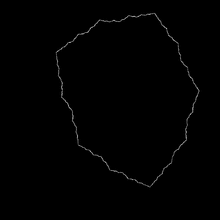
1/3 = [0; 3] = 0.3333333..... = 0.(3)
/* Maxima CAS batch file */ kill(all)$ remvalue(all)$ /* a = [1, 1, ...] = golden ratio */ g: float((1+sqrt(5))/2)$ GiveT(n):= float(cfdisrep([0,3,10^n,g]))$ GiveC(t):= block( [l, c], l:%e^(2*%pi*%i*t), c : (l*(1-l/2))/2, c:float(rectform(c)), return(c) )$ compile(all)$ for n:0 step 1 thru 10 do ( t:GiveT(n), c:GiveC(t), print("n=" ,n ," ; t= ", t , "; c = ", c) );
The result :
n= 0 t= 0.276393202250021 c = 0.5745454151066983 %i + 0.1538380639536643
n= 1 t= 0.3231874668087892 c = 0.6469145331346998 %i - 0.07039249652637808
n= 2 t= 0.3322326933513446 c = 0.649488031636116 %i - 0.1190170769366243
n= 3 t= 0.3332223278292314 c = 0.6495187369145559 %i - 0.1243960357918423
n= 4 t= 0.3333222232791965 c = 0.6495190496732967 %i - 0.1249395463818514
n= 5 t= 0.3333322222327929 c = 0.6495190528066728 %i - 0.1249939540657306
n= 6 t= 0.3333332222223279 c = 0.6495190528380125 %i - 0.1249993954008478
n= 7 t= 0.3333333222222233 c = 0.6495190528383257 %i - 0.1249999395400275
n= 8 t= 0.3333333322222222 c = 0.6495190528383289 %i - 0.1249999939540021
n= 9 t= 0.3333333332222222 c = 0.649519052838329 %i - 0.1249999993954
n= 10 t= 0.3333333333222222 c = 0.649519052838329 %i - 0.1249999999395399
(%i1) a:[0,3,a,g];
(%o1) [0, 3, a, g]
(%i2) cfdisrep(a);
1
(%o2) ---------
1
3 + -----
1
a + -
g
(%i3)
quad precision (t and c ):
// git@gitlab.com:adammajewski/InfoldingSiegelDisk_in_c_1over3_quaddouble.git t(0) = 2.76393202250021030359082633126872376455938164038847427572910275e-01 c = 1.53838063953664121728826496636884090757364247198001213740163411e-01 ; 5.74545415106698547533205192239966882171974656527110206599567294e-01 t(1) = 3.23187466808789167460075188398563024584074865168574811248120429e-01 c = -7.03924965263779817446805013170440359580350303484669206412737432e-02 ; 6.46914533134699876497054948648970463828561836818357035393585013e-01 t(2) = 3.32232693351344645328281111249254263489588693253128095562021379e-01 c = -1.19017076936624259031145944667596002534849695014545153950004772e-01 ; 6.49488031636116063199566861137419722741268462810784951116992269e-01 t(3) = 3.33222327829231396180972123516749255293978654448636072108442295e-01 c = -1.24396035791842227723833496314974550377900499387491577355907843e-01 ; 6.49518736914555954950215798854805983039885153673988260646103979e-01 t(4) = 3.33322223279196467461199806968881974980654735721758806121437081e-01 c = -1.24939546381851514024915251452349793356883503222467666248987991e-01 ; 6.49519049673296680160381595728499835459227600854334414827754792e-01 t(5) = 3.33332222232792869679683559108320427563171464137271516297451542e-01 c = -1.24993954065730675441065991629838614047426783311966520549106346e-01 ; 6.49519052806672859063863722773813069312955136848755592503084124e-01 t(6) = 3.33333222222327929601887145303917917465162347855208962292566660e-01 c = -1.24999395400848041352293443820430989442841091304288844173462574e-01 ; 6.49519052838012418008903728036348898528045582108441153259758357e-01 t(7) = 3.33333322222223279296923970287377310413140932425289152909012301e-01 c = -1.24999939540027553391850682937180513243494903336945859380511500e-01 ; 6.49519052838325819396349608234642964505989043061737603462233217e-01 t(8) = 3.33333332222222232792970144802560581866962241709924341887457124e-01 c = -1.24999993954002182831269818316294274223873134947476282441764677e-01 ; 6.49519052838328953416022146474675036126754173503570601306155105e-01 t(9) = 3.33333333222222222327929702353125377874576632652638574699840874e-01 c = -1.24999999395400212558047347868208906283402972461774034404632366e-01 ; 6.49519052838328984756224669944909300404586792219705302525018521e-01 t(10) = 3.33333333322222222223279297024436353559326388564904699626466712e-01 c = -1.24999999939540021198553937965723010802762347867693302140297851e-01 ; 6.49519052838328985069626700977700316581410665652851539203616381e-01 t(11) = 3.33333333332222222222232792970245268635374696979418341612961499e-01 c = -1.24999999993954002119282885827879858604573185189849864410972761e-01 ; 6.49519052838328985072760721293826315500672008735227141791647866e-01 t(12) = 3.33333333333222222222222327929702453591453528488135105883396848e-01 c = -1.24999999999395400211922563503100579972022557444713095237600026e-01 ; 6.49519052838328985072792061496993373578630511176383107487756736e-01 t(13) = 3.33333333333322222222222223279297024536819635066408216696619311e-01 c = -1.24999999999939540021192199099513183456854230374819467960534760e-01 ; 6.49519052838328985072792374899025049957498862929395598811798211e-01 t(14) = 3.33333333333332222222222222232792970245369101450445609885075510e-01 c = -1.24999999999993954002119219337443349599800479106023686175774584e-01 ; 6.49519052838328985072792378033045366727085635213738283716661855e-01 t(15) = 3.33333333333333222222222222222327929702453691919604237626654112e-01 c = -1.24999999999999395400211921928019255272520717007610023985861823e-01 ; 6.49519052838328985072792378064385569894787301025348531521608111e-01 t(16) = 3.33333333333333322222222222222223279297024536920101142157794353e-01 c = -1.24999999999999939540021192192744674730377477910267401190215182e-01 ; 6.49519052838328985072792378064698971926464323481553400821453061e-01 t(17) = 3.33333333333333332222222222222222232792970245369201916521359471e-01 c = -1.24999999999999993954002119219273894965069001852640340429175752e-01 ; 6.49519052838328985072792378064702105946781093711913538281273390e-01 t(18) = 3.33333333333333333222222222222222222327929702453692020070313376e-01 c = -1.24999999999999999395400211921927383771427212725879688582341355e-01 ; 6.49519052838328985072792378064702137286984261414222937744638416e-01 t(19) = 3.33333333333333333322222222222222222223279297024536920201608234e-01 c = -1.24999999999999999939540021192192738319891924397994124922164696e-01 ; 6.49519052838328985072792378064702137600386293091246037537360833e-01 t(20) = 3.33333333333333333332222222222222222222232792970245369202016987e-01 c = -1.24999999999999999993954002119219273831416684471053474052374312e-01 ; 6.49519052838328985072792378064702137603520313408016268541086146e-01 1/3 = 3.33333333333333333333333333333333333333333333333333333333333333e-01 c = -1.25000000000000000000000000000000000000000000000000000000000000e-01 ; 6.49519052838328985072792378064702137603551970178892735520927617e-01
9/13
Example from scholarpedia[35]
fpprec:60; a:[4,4,1,2,4,4,4,4,1,1,1,1,1,1,1,1,1]; b:cfdisrep(a); c:bfloat(b); e0:bfloat(cfdisrep([0,1,2,4,4,c])); e1:bfloat(cfdisrep([0,1,2,4,4,10,c])); e2:bfloat(cfdisrep([0,1,2,4,4,10^2,c])); e3:bfloat(cfdisrep([0,1,2,4,4,10^3,c])); e4:bfloat(cfdisrep([0,1,2,4,4,10^4,c])); e5:bfloat(cfdisrep([0,1,2,4,4,10^5,c])); e6:bfloat(cfdisrep([0,1,2,4,4,10^6,c])); e7:bfloat(cfdisrep([0,1,2,4,4,10^7,c])); e8:bfloat(cfdisrep([0,1,2,4,4,10^8,c])); e9:bfloat(cfdisrep([0,1,2,4,4,10^9,c])); e10:bfloat(cfdisrep([0,1,2,4,4,10^10,c])); d01:e0-e1; d12:e1-e2; d23:e2-e3; d34:e3-e4; d45:e4-e5; d56:e5-e6; d67:e6-e7; d78:e7-e8; d89:e8-e9; d910:e9-e10; plot2d( [discrete, [ 0, 1, 2, 3, 4, 5, 6, 7, 8, 9, 10], [ e0, e1, e2, e3, e4, e5, e6, e7, e8, e9, e10] ]); plot2d( [discrete, [ 1, 2, 3, 4, 5, 6, 7, 8, 9,10], [ d01, d12, d23, d34, d45, d56, d67, d78, d89, d910] ]);
result :
/* http://maxima-online.org/?inc=r972897020*/
(%i1) fpprec:60;
(%o1) 60
(%i2) a:[4,4,1,2,4,4,4,4,1,1,1,1,1,1,1,1,1];
(%o2) [4, 4, 1, 2, 4, 4, 4, 4, 1, 1, 1, 1, 1, 1, 1, 1, 1]
(%i3) b:cfdisrep(a);
1
(%o3) 4 + -------------------------------------------------------------
1
4 + ---------------------------------------------------------
1
1 + -----------------------------------------------------
1
2 + -------------------------------------------------
1
4 + ---------------------------------------------
1
4 + -----------------------------------------
1
4 + -------------------------------------
1
4 + ---------------------------------
1
1 + -----------------------------
1
1 + -------------------------
1
1 + ---------------------
1
1 + -----------------
1
1 + -------------
1
1 + ---------
1
1 + -----
1
1 + -
1
(%i4) c:bfloat(b);
(%o4) 4.21317492083944457390374624758406097076199745041327978287391b0
(%i5) e0:bfloat(cfdisrep([0,1,2,4,4,c]));
(%o5) 6.90983385919269333377918690283855111536837789999636063622128b-1
(%i6) e1:bfloat(cfdisrep([0,1,2,4,4,10,c]));
(%o6) 6.90940653590858345205900333693231459583929903277216782489572b-1
(%i7) e2:bfloat(cfdisrep([0,1,2,4,4,10^2,c]));
(%o7) 6.90912381108070743953290526690429251279660195160237673633147b-1
(%i8) e3:bfloat(cfdisrep([0,1,2,4,4,10^3,c]));
(%o8) 6.90909421331077674912831355964859580252020147075327146840293b-1
(%i9) e4:bfloat(cfdisrep([0,1,2,4,4,10^4,c]));
(%o9) 6.90909123965376225147306218871548821073377014383362752163859b-1
(%i10) e5:bfloat(cfdisrep([0,1,2,4,4,10^5,c]));
(%o10) 6.90909094214860373154103745626419162194365585020091374566415b-1
(%i11) e6:bfloat(cfdisrep([0,1,2,4,4,10^6,c]));
(%o11) 6.90909091239669264887898182284536032143262445829248943506691b-1
(%i12) e7:bfloat(cfdisrep([0,1,2,4,4,10^7,c]));
(%o12) 6.90909090942148758764580793509997058314465248663422318011972b-1
(%i13) e8:bfloat(cfdisrep([0,1,2,4,4,10^8,c]));
(%o13) 6.90909090912396694199216055201332263713180254323741379104146b-1
(%i14) e9:bfloat(cfdisrep([0,1,2,4,4,10^9,c]));
(%o14) 6.9090909090942148760314918534473410035349593667510644807155b-1
(%i15) e10:bfloat(cfdisrep([0,1,2,4,4,10^10,c]));
(%o15) 6.90909090909123966942147194332785516326702737819678667743891b-1
(%i16) d01:e0-e1;
(%o16) 4.27323284109881720183565906236519529078867224192811325562048b-5
(%i17) d12:e1-e2;
(%o17) 2.82724827876012526098070028022083042697081169791088564253857b-5
(%i18) d23:e2-e3;
(%o18) 2.95977699306904045917072556967102764004808491052679285309819b-6
(%i19) d34:e3-e4;
(%o19) 2.97365701449765525137093310759178643132691964394676434841921b-7
(%i20) d45:e4-e5;
(%o20) 2.97505158519932024732451296588790114293632713775974431973635b-8
(%i21) d56:e5-e6;
(%o21) 2.97519110826620556334188313005110313919084243105972446795396b-9
(%i22) d67:e6-e7;
(%o22) 2.97520506123317388774538973828797197165826625494718990624414b-10
(%i23) d78:e7-e8;
(%o23) 2.97520645653647383086647946012849943396809389078262402933403b-11
(%i24) d89:e8-e9;
(%o24) 2.97520659606686985659816335968431764863493103259592529156942b-12
(%i25) d910:e9-e10;
(%o25) 2.97520661001991011948584026793198855427780327658967717649496b-13
These Siegel disks have 13 digits. SO it will be near t=n/13, probably :
this number is irreducible and it's decimal expansion has period 6 [36]
Numerical comutations goes near :
It is irreducible fraction . It's decimal expansion has period 2 [37]
Important numbers :
8/13 = 0.6153846153846154 = [0; 1, 1, 1, 1, 2] 38/55 = 0.690909090909090(90) = [0; 1, 2, 4, 4] 9/13 = 0.692307692307(692307) = [0; 1, 2, 4]
QUADRATIC SIEGEL DISKS WITH SMOOTH BOUNDARIES
Example by XAVIER BUFF AND ARNAUD CHERITAT[38]
α = ( 5 + 1)/2 = [1, 1, 1, 1, . . .],
α(1) = [1, 1, 1, 1, 1, 1, 25, 1, 1, 1, . . .]
α(2) = [1, 1, 1, 1, 1, 1, 25, 1010 , 1, 1, 1, . . .]
2/7
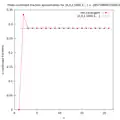 finite continued fractions aproximation to [0;1,1,1,....
finite continued fractions aproximation to [0;1,1,1,.... Critical Orbit, Inner and outer circle of [0;3,2,1000,1...] Julia set
Critical Orbit, Inner and outer circle of [0;3,2,1000,1...] Julia set Julia set [0;3,2,1000,1...
Julia set [0;3,2,1000,1... Critical orbit
Critical orbit
rotation number t is :[39]
In Maxima CAS one can compute it :
(%i2) kill(all) (%o0) done (%i1) a:[0,3,2,1000,1,1,1,1,1,1,1,1,1,1,1,1,1,1,1,1,1,1,1,1,1,1,1,1,1,1,1,1,1,1,1,1,1,1,1,1,1,1,1,1,1,1,1,1,1,1,1,1,1,1,1,1,1,1,1,1,1,1,1,1,1,1,1,1,1,1,1,1,1,1,1,1,1,1,1,1,1,1,1,1,1,1,1,1,1,1,1,1,1,1,1,1,1,1,1,1,1,1,1,1,1,1,1,1,1,1,1,1,1,1,1,1,1,1,1,1,1,1,1,1,1,1,1,1,1,1,1,1,1,1,1,1,1,1,1,1,1,1,1,1,1,1,1,1,1,1,1,1,1] (%o1) [0,3,2,1000,1,1,1,1,1,1,1,1,1,1,1,1,1,1,1,1,1,1,1,1,1,1,1,1,1,1,1,1,1,1,1,1,1,1,1,1,1,1,1,1,1,1,1,1,1,1,1,1,1,1,1,1,1,1,1,1,1,1,1,1,1,1,1,1,1,1,1,1,1,1,1,1,1,1,1,1,1,1,1,1,1,1,1,1,1,1,1,1,1,1,1,1,1,1,1,1,1,1,1,1,1,1,1,1,1,1,1,1,1,1,1,1,1,1,1,1,1,1,1,1,1,1,1,1,1,1,1,1,1,1,1,1,1,1,1,1,1,1,1,1,1,1,1,1,1,1,1,1,1] (%i2) t:cfdisrep(a) (%o2) (1)/(3+(1)/(2+(1)/(1000+(1)/(1+(1)/(1+(1)/(1+(1)/(1+(1)/(1+(1)/(1+(1)/(1+(1)/(1+(1)/(1+(1)/(1+(1)/(1+(1)/(1+(1)/(1+(1)/(1+(1)/(1+(1)/(1+(1)/(1+(1)/(1+(1)/(1+(1)/(1+ (1)/(1+(1)/(1+(1)/(1+(1)/(1+(1)/(1+(1)/(1+(1)/(1+(1)/(1+(1)/(1+(1)/(1+(1)/(1+(1)/(1+(1)/(1+(1)/(1+(1)/(1+(1)/(1+(1)/(1+(1)/(1+(1)/(1+(1)/(1+(1)/(1+(1)/(1+(1)/(1+(1)/(1+(1)/(1+(1)/(1+(1)/(1+(1)/(1+(1)/(1+(1)/(1+(1)/(1+(1)/(1+(1)/(1+(1)/(1+(1)/(1+(1)/(1+(1)/(1+(1)/(1+(1)/(1+(1)/(1+(1)/(1+(1)/(1+(1)/(1+(1)/(1+(1)/(1+(1)/(1+(1)/(1+(1)/(1+(1)/(1+(1)/(1+(1)/(1+(1)/(1+1/(1+1/(1+1/(1+1/(1+1/(1+1/(1+1/(1+1/(1+1/(1+1/(1+1/(1+1/(1+1/(1+1/(1+1/(1+1/(1+1/(1+1/(1+1/(1+1/(1+1/(1+1/(1+1/(1+1/(1+1/(1+1/(1+1/(1+1/(1+1/(1+1/(1+1/(1+1/(1+1/(1+1/(1+1/(1+1/(1+1/(1+1/(1+1/(1+1/(1+1/(1+1/(1+1/(1+1/(1+1/(1+1/(1+1/(1+1/(1+1/(1+1/(1+1/(1+1/(1+1/(1+1/(1+1/(1+1/(1+1/(1+1/(1+1/(1+1/(1+1/(1+1/(1+1/(1+1/(1+1/(1+1/(1+1/(1+1/(1+1/(1+1/(1+1/(1+1/(1+1/(1+1/(1+1/(1+1/(1+1/1))))))))))))))))))))))))))))))))))))))))))))))))))))))))))))))))))))))))))))))))))))))))))))))))))))))))))))))))))))))))))))))))))))))))))))))))))))))) (%i3) float(t) (%o3) .2857346725405882 (%i4) l:%e^(2*%pi*%i*t) (%o4) %e^((2*%i*%pi)/(3+(1)/(2+(1)/(1000+(1)/(1+(1)/(1+(1)/(1+(1)/(1+(1)/(1+(1)/(1+(1)/(1+(1)/(1+(1)/(1+(1)/(1+(1)/(1+(1)/(1+(1)/(1+(1)/(1+(1)/(1+(1)/(1+(1)/(1+(1)/(1+(1)/(1+(1)/(1+(1)/(1+(1)/(1+(1)/(1+(1)/(1+(1)/(1+(1)/(1+(1)/(1+(1)/(1+(1)/(1+(1)/(1+(1)/(1+(1)/(1+(1)/(1+(1)/(1+(1)/(1+(1)/(1+(1)/(1+(1)/(1+(1)/(1+(1)/(1+(1)/(1+(1)/(1+(1)/(1+(1)/(1+(1)/(1+(1)/(1+(1)/(1+(1)/(1+(1)/(1+(1)/(1+(1)/(1+(1)/(1+(1)/(1+(1)/(1+(1)/(1+(1)/(1+(1)/(1+(1)/(1+(1)/(1+(1)/(1+(1)/(1+(1)/(1+(1)/(1+(1)/(1+(1)/(1+(1)/(1+(1)/(1+(1)/(1+(1)/(1+(1)/(1+(1)/(1+(1)/(1+1/(1+1/(1+1/(1+1/(1+1/(1+1/(1+1/(1+1/(1+1/(1+1/(1+1/(1+1/(1+1/(1+1/(1+1/(1+1/(1+1/(1+1/(1+1/(1+1/(1+1/(1+1/(1+1/(1+1/(1+1/(1+1/(1+1/(1+1/(1+1/(1+1/(1+1/(1+1/(1+1/(1+1/(1+1/(1+1/(1+1/(1+1/(1+1/(1+1/(1+1/(1+1/(1+1/(1+1/(1+1/(1+1/(1+1/(1+1/(1+1/(1+1/(1+1/(1+1/(1+1/(1+1/(1+1/(1+1/(1+1/(1+1/(1+1/(1+1/(1+1/(1+1/(1+1/(1+1/(1+1/(1+1/(1+1/(1+1/(1+1/(1+1/(1+1/(1+1/(1+1/(1+1/(1+1/(1+1/(1+1/1)))))))))))))))))))))))))))))))))))))))))))))))))))))))))))))))))))))))))))))))))))))))))))))))))))))))))))))))))))))))))))))))))))))))))))))))))))))))) (%i5) c:(l*(1-l/2))/2 (%o5) ((1-(%e^((2*%i*%pi)/(3+(1)/(2+(1)/(1000+(1)/(1+(1)/(1+(1)/(1+(1)/(1+(1)/(1+(1)/(1+(1)/(1+(1)/(1+(1)/(1+(1)/(1+(1)/(1+(1)/(1+(1)/(1+(1)/(1+(1)/(1+(1)/(1+(1)/(1+(1)/(1+(1)/(1+(1)/(1+(1)/(1+(1)/(1+(1)/(1+(1)/(1+(1)/(1+(1)/(1+(1)/(1+(1)/(1+(1)/(1+(1)/(1+(1)/(1+(1)/(1+(1)/(1+(1)/(1+(1)/(1+(1)/(1+(1)/(1+(1)/(1+(1)/(1+(1)/(1+(1)/(1+(1)/(1+(1)/(1+(1)/(1+(1)/(1+(1)/(1+(1)/(1+(1)/(1+(1)/(1+(1)/(1+(1)/(1+(1)/(1+(1)/(1+(1)/(1+(1)/(1+(1)/(1+(1)/(1+(1)/(1+(1)/(1+(1)/(1+(1)/(1+(1)/(1+(1)/(1+(1)/(1+(1)/(1+(1)/(1+(1)/(1+(1)/(1+(1)/(1+(1)/(1+(1)/(1+(1)/(1+1/(1+1/(1+1/(1+1/(1+1/(1+1/(1+1/(1+1/(1+1/(1+1/(1+1/(1+1/(1+1/(1+1/(1+1/(1+1/(1+1/(1+1/(1+1/(1+1/(1+1/(1+1/(1+1/(1+1/(1+1/(1+1/(1+1/(1+1/(1+1/(1+1/(1+1/(1+1/(1+1/(1+1/(1+1/(1+1/(1+1/(1+1/(1+1/(1+1/(1+1/(1+1/(1+1/(1+1/(1+1/(1+1/(1+1/(1+1/(1+1/(1+1/(1+1/(1+1/(1+1/(1+1/(1+1/(1+1/(1+1/(1+1/(1+1/(1+1/(1+1/(1+1/(1+1/(1+1/(1+1/(1+1/(1+1/(1+1/(1+1/(1+1/(1+1/(1+1/(1+1/(1+1/(1+1/(1+1/(1+1/1)))))))))))))))))))))))))))))))))))))))))))))))))))))))))))))))))))))))))))))))))))))))))))))))))))))))))))))))))))))))))))))))))))))))))))))))))))))))))/(2))*%e^((2*%i*%pi)/(3+(1)/(2+(1)/(1000+(1)/(1+(1)/(1+(1)/(1+(1)/(1+(1)/(1+(1)/(1+(1)/(1+(1)/(1+(1)/(1+(1)/(1+(1)/(1+(1)/(1+(1)/(1+(1)/(1+(1)/(1+(1)/(1+(1)/(1+(1)/(1+(1)/(1+(1)/(1+(1)/(1+(1)/(1+(1)/(1+(1)/(1+(1)/(1+(1)/(1+(1)/(1+(1)/(1+(1)/(1+(1)/(1+(1)/(1+(1)/(1+(1)/(1+(1)/(1+(1)/(1+(1)/(1+(1)/(1+(1)/(1+(1)/(1+(1)/(1+(1)/(1+(1)/(1+(1)/(1+(1)/(1+(1)/(1+(1)/(1+(1)/(1+(1)/(1+(1)/(1+(1)/(1+(1)/(1+(1)/(1+(1)/(1+(1)/(1+(1)/(1+(1)/(1+(1)/(1+(1)/(1+(1)/(1+(1)/(1+(1)/(1+(1)/(1+(1)/(1+(1)/(1+(1)/(1+(1)/(1+(1)/(1+(1)/(1+(1)/(1+(1)/(1+(1)/(1+(1)/(1+1/(1+1/(1+1/(1+1/(1+1/(1+1/(1+1/(1+1/(1+1/(1+1/(1+1/(1+1/(1+1/(1+1/(1+1/(1+1/(1+1/(1+1/(1+1/(1+1/(1+1/(1+1/(1+1/(1+1/(1+1/(1+1/(1+1/(1+1/(1+1/(1+1/(1+1/(1+1/(1+1/(1+1/(1+1/(1+1/(1+1/(1+1/(1+1/(1+1/(1+1/(1+1/(1+1/(1+1/(1+1/(1+1/(1+1/(1+1/(1+1/(1+1/(1+1/(1+1/(1+1/(1+1/(1+1/(1+1/(1+1/(1+1/(1+1/(1+1/(1+1/(1+1/(1+1/(1+1/(1+1/(1+1/(1+1/(1+1/(1+1/(1+1/(1+1/(1+1/(1+1/(1+1/(1+1/(1+1/(1+1/1)))))))))))))))))))))))))))))))))))))))))))))))))))))))))))))))))))))))))))))))))))))))))))))))))))))))))))))))))))))))))))))))))))))))))))))))))))))))))/(2) (%i6) float(rectform(c)) (%o6) .5959783359361234*%i+.1138915132131216
So
t = .2857346725405882 c = 0.113891513213121 +0.595978335936124 i
How one can find limit of [3,2,1000,1,...] ?
Here is explanation of Bill Wood
"I don't know if Maxima knows much about the algebra of continued fractions, but it can be of some help hacking out the manipulation details of a derivation. A most useful fact is that
[a1, a2, a3, ...] = a1 + 1/[a2, a3, ...]
provided the continued fraction converges. If we apply that three times by hand to [3, 2, 1000, 1, 1, ...] we obtain
3 + 1/(2 + 1/(1000 + 1/[1, 1, ...]))
Now it is known that [1, 1, ...] converges to the Golden Ratio = (1+sqrt(5))/2. So now we can use Maxima as follows:
(%i20) 3+(1/(2+(1/(1000+(1/((1+sqrt(5))/2))))));
1
(%o20) ---------------------- + 3
1
------------------ + 2
2
----------- + 1000
sqrt(5) + 1
(%i21) factor(%o13);
7003 sqrt(5) + 7017
(%o21) -------------------
2001 sqrt(5) + 2005
(%i22) %o21,numer;
(%o22) 3.499750279196346
You set a to [0, 3, 2, 1000, 1, 1, ...], which by our useful fact must be the reciprocal of [3, 2, 1000, 1, 1, ...], and indeed the reciprocal of 3.499750279196346 is 0.2857346725405882, which is what your float(t) evaluates to, so we seem to get consistent results.
If all of the continued fractions for the rotation numbers exhibited on the link you provided do end up repeating 1 forever then the method I used above can be used to determine their limits as ratios of linear expressions in sqrt(5)." Bill Wood
Check fraction:[40]
2/7 = [0; 3, 2] = 0.285714285714285714285714285714285714285714285714285714285... = 0.(28571)
/* Maxima CAS batch file */ kill(all)$ remvalue(all)$ /* a = [1, 1, ...] = golden ratio */ g: float((1+sqrt(5))/2)$ GiveT(n):= float(cfdisrep([0,3,2,10^n,g]))$ GiveC(t):= block( [l, c], l:%e^(2*%pi*%i*t), c : (l*(1-l/2))/2, c:float(rectform(c)), return(c) )$ compile(all)$ for n:0 step 1 thru 10 do ( t:GiveT(n), c:GiveC(t), print("n=", n , " ; t= ", t, " ; c = ", c) );
and result :
"n="" "0" "" ; t= "" "0.2956859994078892" "" ; c = "" "0.6153124581224951*%i+0.06835556662164869" " "n="" "1" "" ; t= "" "0.2875617458610296" "" ; c = "" "0.599810068302661*%i+0.1057522049785167" " "n="" "2" "" ; t= "" "0.285916253540726" "" ; c = "" "0.5963646240901801*%i+0.1130872227062027" " "n="" "3" "" ; t= "" "0.2857346725405881" "" ; c = "" "0.5959783359361234*%i+0.1138915132131216" " "n="" "4" "" ; t= "" "0.2857163263170416" "" ; c = "" "0.5959392401496606*%i+0.1139727184036316" " "n="" "5" "" ; t= "" "0.2857144897937824" "" ; c = "" "0.5959353258460209*%i+0.1139808467588366" " "n="" "6" "" ; t= "" "0.2857143061224276" "" ; c = "" "0.5959349343683512*%i+0.1139816596727942" " "n="" "7" "" ; t= "" "0.2857142877551018" "" ; c = "" "0.5959348952201112*%i+0.1139817409649742" " "n="" "8" "" ; t= "" "0.2857142859183673" "" ; c = "" "0.5959348913052823*%i+0.1139817490942002" " "n="" "9" "" ; t= "" "0.2857142857346939" "" ; c = "" "0.5959348909137995*%i+0.1139817499071228" " "n="" "10" "" ; t= "" "0.2857142857163265" "" ; c = "" "0.5959348908746511*%i+0.1139817499884153" "
or using quad double precision ( qd library) :
./a.out
t(0) = 2.95685999407889202537083517598191479880016272621355940112392033e-01
t(1) = 2.87561745861029587995763349374215634699576366286473943622953355e-01
t(2) = 2.85916253540726005296290351777281930430489555597203400050155169e-01
t(3) = 2.85734672540588170268886130620030074831025799037914834916050614e-01
t(4) = 2.85716326317041655001121670485871240052920659174284332597727197e-01
t(5) = 2.85714489793782460278353122604001584582831972498394265344044955e-01
t(6) = 2.85714306122427620319960416932943500595980573209849938259909447e-01
t(7) = 2.85714287755101827223406574888790339883583192331314008460721020e-01
t(8) = 2.85714285918367344802846109454092778340593443209054635310671634e-01
t(9) = 2.85714285734693877529661113954572642424219379874139361821960174e-01
t(10) = 2.85714285716326530612031305016895554055165716643985018539739541e-01
t(11) = 2.85714285714489795918365211009352427817161964062263710683311655e-01
2/7 = 2.85714285714285714285714285714285714285714285714285714285714286e-01
2/9
(%i7) cf(2/9); (%o7) [0, 4, 2] (%i8) cf(2/9 + 0.1); (%o8) [0, 3, 9, 1, 2] (%i9) cf(2/9 + 0.01); (%o9) [0, 4, 3, 3, 1, 3, 4] (%i10) cf(2/9 + 0.001); (%o10) [0, 4, 2, 11, 1, 9, 8] (%i11) cf(2/9 + 0.0001); (%o11) [0, 4, 2, 123, 81] (%i12) cf(2/9 + 0.00001); (%o12) [0, 4, 2, 1234, 8, 10] (%i13) cf(2/9 + 0.000001); (%o13) [0, 4, 2, 12345, 4, 3, 1, 4] (%i14) cf(2/9 + 0.0000001); (%o14) [0, 4, 2, 123456, 2, 1, 8] (%i15) cf(2/9 + 0.00000001); (%o15) [0, 4, 2, 1234567, 2] (%i16) cf(2/9 + 0.000000001); (%o16) [0, 4, 2, 12345678] (%i17) cf(2/9 + 0.0000000001); (%o17) [0, 4, 2, 123456806] (%i18) cf(2/9 + 0.00000000001); (%o18) [0, 4, 2, 1234571860] (%i19) cf(2/9 + 0.000000000001); (%o19) [0, 4, 2, 12345935203] (%i20) cf(2/9 + 0.0000000000001); (%o20) [0, 4, 2, 123453937153] (%i21) cf(2/9 + 0.00000000000001); (%o21) [0, 4, 2, 1234539371537] (%i22) cf(2/9 + 0.000000000000001); (%o22) [0, 4, 2, 12794317123211] (%i23)
Questions
- is it possible to find function which maps circle to Siegel disc ?
- what happens between virtual Siegel disk and parabolic critical orbit ?
Further reading
- cylinder reormalization
- Arnaud Chéritat : presentation Rome, Avril 2009 : Siegel disks
- Boundaries of Siegel disks - numerical studies of their dynamics and regularity by Rafael de la Llave, Nikola P. Petrov
- Fixed points and circle maps by Ricardo Pérez-Marco
- fractint- Julia Sets, Orbits,Siegel Disks
- youtube: Collapse of a Siegel Disk Gary by Welz
- small divisors[41]
References
- ↑ wikipedia : siegel disc
- ↑ encyclopedia of math : Siegel disc ( see discrete case )
- ↑ More Fun With Irrational Internal Angles by Faber McMullen
- ↑ wikipedia : Irrational number
- ↑ Siegel disks by Xavier Buff and Arnaud Ch ́ritat e Univ. Toulouse Roma, April 2009
- ↑ wikipedia : Conformal radius
- ↑ scholarpedia : Quadratic Siegel disks
- ↑ scholarpedia : Quadratic_Siegel_disks
- ↑ Image InfoldingSiegelDisk.gif from Scholarpedia
- ↑ Computability of Julia sets by Mark Braverman, Michael Yampolsky
- ↑ SEMI-CONTINUITY OF SIEGEL DISKS UNDER PARABOLIC IMPLOSION by ARNAUD CHERITAT
- ↑ Fractal Geometry Mathematical Foundations and Applications, 2nd Edition Kenneth Falconer
- ↑ A tutorial on the visualization of forward orbits associated with Siegel disks in the quadratic Julia sets by G.Todd Miller
- ↑ Combined Methods of Depicting Julia Sets by Chris King
- ↑ More Fun With Irrational Internal Angles by Faber
- ↑ Irrationality of Fast Converging Series of Rational Numbers By Daniel Duverney
- ↑ NON-COMPUTABLE JULIA SETS by M. BRAVERMAN, M. YAMPOLSKY
- ↑ Mandelbrot Sequences and Orbits by Stefan Forcey
- ↑ Jay Hill : JuliaSetsOrbitsSiegelDisks.txt
- ↑ multiplier in wikipedia
- ↑ Golden ratio at wikipedia
- ↑ Golden Ratio Julia Set video by fractal
- ↑ wikipedia : Continued_fraction
- ↑ Combined Methods of Depicting Julia Sets by Chris King
- ↑ Golden mean Siegel disk by Curtis T McMullen
- ↑ Siegel disc by Jim Muth
- ↑ Siegel discs by Davoud Cheraghi
- ↑ a bettter Siegel disk program in Mathematica From Roger Bagula
- ↑ Xander's blog
- ↑ Galerie II : Dynamique holomorphe et analyse complexe by Arnaud Chéritat
- ↑ OLD AND NEW ON QUADRATIC SIEGEL DISKS by SAEED ZAKERI
- ↑ Rotation Sets and Polynomial Dynamics by Zakeri
- ↑ integer sequence id=A000045
- ↑ wolframalpha : continued+fraction[0;2,1,GoldenRatio]
- ↑ Infolding Siegel Disk by Arnaud Chéritat
- ↑ wolfram alpha : 9/13
- ↑ wolfram alpha : 38/55
- ↑ SIEGEL DISKS WITH SMOOTH BOUNDARIES ́ ARTUR AVILA, XAVIER BUFF, AND ARNAUD CHERITAT
- ↑ Some examples of quadratic polynomial Siegel disks by Davoud Cheraghi
- ↑ wolfram alpha : 2/7
- ↑ An Introduction To Small Divisors by S. Marmi
- Local connectivity of some Julia sets containing a circle with an irrational rotation. / Petersen, Carsten Lunde. In: Acta Mathematica, Vol. 177, No. 2, 1996, p. 163-224.
- Building blocks for quadratic Julia sets. Article in Transactions of the American Mathematical Society 351(3):1171-1201 · January 1999 DOI: 10.1090/S0002-9947-99-02346-6